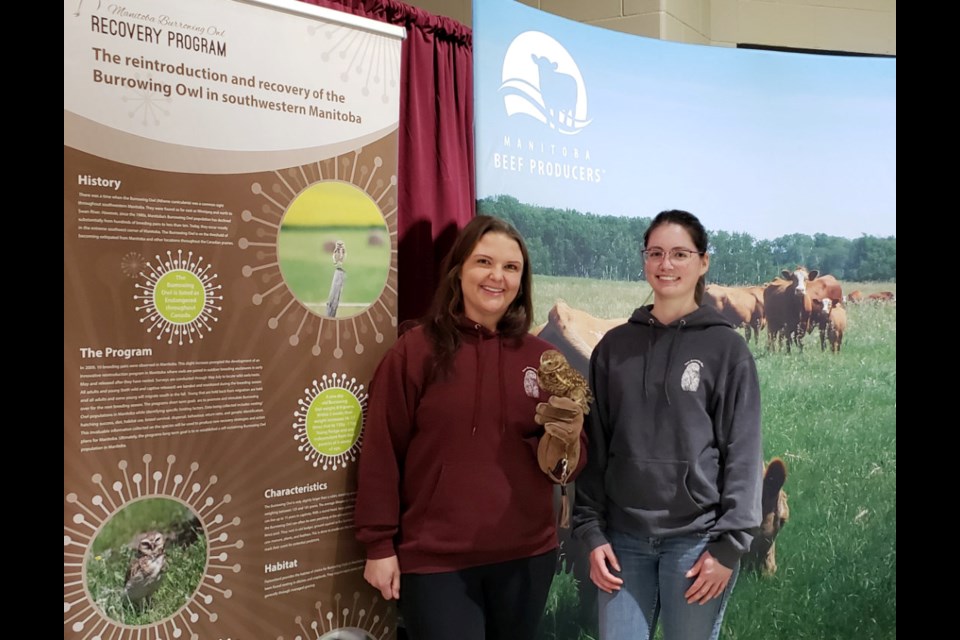How can a tiny ground nesting owl survive among predators, loss of habitat and changing agricultural practices? The burrowing owl, the size of a robin, but fluffier, is federally and provincially an endangered species. Manitoba Burrowing Owl Recovery Program has had a plan in place for a decade now to re-established nesting pairs in southwest Manitoba.
Bindi is the current ambassador for this program. She spent a couple of days at the Royal Manitoba Winter Fair promoting the program. The tiny burrowing owl drew a crowd, often perched on the glove of her handler, Alexandra Froese, in a booth alongside the Manitoba Cattle Producers.
“It was a constant flow of traffic and lots of people interested,” said Froese, Executive Director, Manitoba Burrowing Owl Recovery Program (MBORP).
Froese fell in love with the tiny owls when she first studied the species in 2010 and by 2013, she’d founded the MBORP recovery program. For a decade Froese has worked to educate the public and particularly the keepers of the land - farmers and ranchers - about the burrowing owl.
These small predators dine on tiny rodents, and they love grasshoppers. They are a farmer’s friend. It’s a natural fit to have support from groups like the Manitoba Cattle Producers.
The Souris River Conservation District has been a steady funding partner. In 2020 the Manitoba Beef Producers became funding partners also, which Froese hopes will continue.
She explains, “We rely on private and partner funding. In the last few years, we’ve struggled with securing public funding. So, I’ve had to find sponsorships with private organizations and the Beef Producers are one of those.”
WHY THE URGENCY?
“Burrowing Owls are one of the most endangered birds we have here in Manitoba,” says Froese. “They’re grassland dependent species. Burrowing owls nest underground, but they need the grass nice and short.”
Along with navigating around their burrows (usually abandoned gopher, fox and badger dens), they need to be able to spot predators.
“When the grass is really tall, they aren’t able to see potential predators. … “Because they’re on the ground they’re really susceptible to mammalian predators and also large avian predators as well. Larger owls and hawks. So, they usually don’t select spots with tall grass.”
The young have a unique means of protection.
“One really neat adaptation that baby burrowing owls have, is a rattlesnake call. So, if they’re down in the burrow and helpless… and there’s a predator trying to come down the burrow, they project this rattlesnake call as a group. That can scare away badgers and foxes.”
Koko has been part of an education program that was presented in Fort La Bosse School Division. Now, Bindi has taken over from Koko as the education owl and she charmed fair-goers recently. “A lot of people were surprised by her size. A really petite bird.”
Burrowing owls are the second smallest owl in Manitoba, the northern saw-whet is smaller.
Many people may never see a wild burrowing owl. “Finding a burrowing owl is like finding a needle in the haystack, especially because they’re on the ground, maybe tucked partly in the burrow – well camouflaged.”
Koko, almost 10, no longer sees perfectly and has retired from her PR work. With permits to allow Froese to keep an endangered wildlife species, both Bindi and Koko live in her home. They are “free flying. They have their own room in my home,” says Froese.
From May to August, Bindi visits schools and communities where Froese engages landowners, looking to improve habitat for burrowing owls. Where landowners are agreeable, MBORP will install artificial burrows - a section of weeping tile and a large bucket, placed amongst other natural burrows - as another option for nesting owls.
By demonstrating the value of this unique owl, the species has gained ground, so to speak, but it’s slow going. The wild population of Burrowing Owls in Manitoba declined steeply and steadily since the 1980's. Between 2009-2016, only eight pairs and 18 individual owls have been observed or reported during the breeding season. In 2010 and 2011, select young were removed from wild nests. These wild young were paired with founding owls to increase genetic diversity in MBORP's breeding program.
To learn more, go to www.mborp.ca




